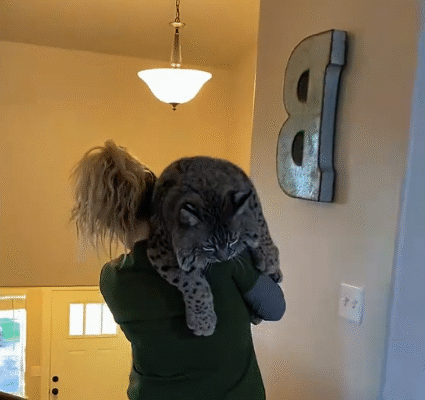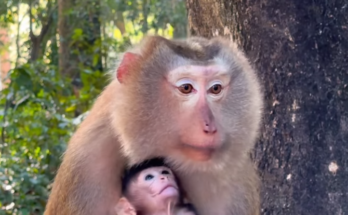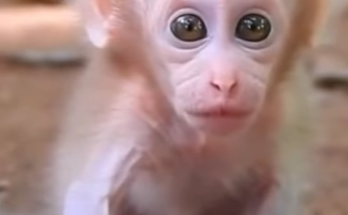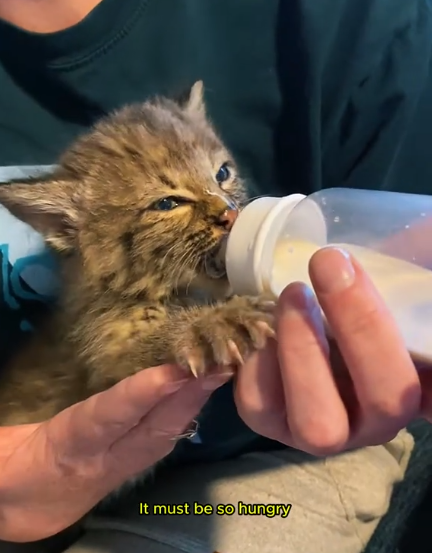
It was a crisp autumn afternoon when I first heard the soft, plaintive cries coming from the edge of the forest behind my house. The sound was faint but persistent, cutting through the rustling leaves and the whisper of the wind. Curiosity—and a sense of something deeper—drew me closer.
As I moved through the underbrush, my eyes scanned for the source. Then, nestled between the roots of a fallen oak tree, I saw her—a tiny bobcat kitten, no more than a few weeks old, shivering and alone. Her fur was a soft tawny color, dotted with faint spots, and her eyes, wide and amber, reflected both fear and confusion.
The forest was no place for a defenseless kitten, especially one so young. I immediately sensed that she was an orphan, vulnerable and in desperate need of help.
I gently scooped her up, careful not to frighten her further. She trembled but did not resist. Somehow, she seemed to understand that I meant no harm.
I named her Willow.
Bringing an orphaned wild animal into your home is no small task. Willow’s arrival meant a whirlwind of research, calls to wildlife rehabilitators, and countless hours devoted to her care.
The first challenge was feeding. A bobcat kitten this young needed a very specific diet—something that mimicked the mother’s milk as closely as possible. I ordered a special formula used for wild felines and fed her every few hours with a tiny syringe.
Willow’s eyes began to brighten with each passing day. She grew stronger, her legs steadier, and her once-constant trembling faded. I built her a cozy space by the fireplace with soft blankets and a warm heating pad. She would curl up there, often falling asleep mid-feed, her small body rising and falling gently.
Despite her wild nature, Willow showed a surprising amount of trust. She followed me around the house with tentative steps, sometimes batting at my shoelaces or pouncing on my fingers as if testing her hunting skills.
As days turned to weeks, I learned more about the unique and fascinating world of bobcats. They are solitary, elusive creatures known for their agility and keen senses. Unlike domestic cats, they have sharp, strong legs built for powerful jumps and silent stalking.
Willow’s instincts often surprised me. She was drawn to shadows, her ears twitching at the slightest sound, and her eyes fixed intently on even the smallest movement. I had to be careful not to overwhelm her with loud noises or sudden changes.
Yet, despite her wild instincts, she grew comfortable in our home. I introduced toys that mimicked prey—feathers on strings, small balls, and crinkly tunnels. Watching her pounce and stalk was a glimpse into the wild world she came from.
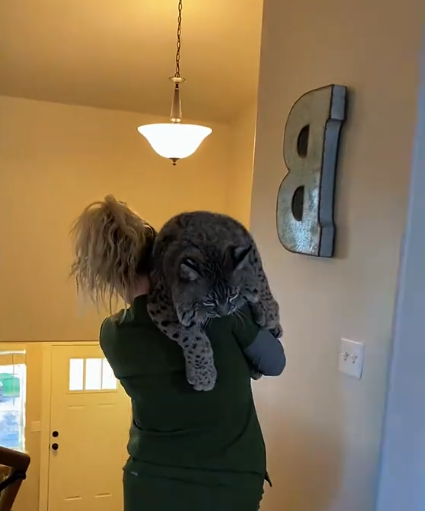
One of the most emotional moments came when I realized I had become her surrogate family. Bobcats learn survival skills from their mothers in the wild—how to hunt, climb, and navigate their environment. Without her mother, Willow lacked these crucial lessons.
I began to teach her. We ventured outside to a secure enclosure I built behind the house—a place where she could practice climbing small trees and stalking hidden toys. I threw small pieces of raw meat to encourage her to pounce and catch.
Willow’s progress was astounding. She developed strength and coordination, and her wild nature blossomed alongside the trust she had in me.
Despite the joy she brought, I knew deep down that Willow belonged in the wild. My heart ached with the knowledge that one day, she would have to leave the safety of our home and face the forest on her own.
I contacted a local wildlife rehabilitation center that specialized in big cats and bobcats. The experts there helped me understand the importance of gradual reintroduction into the wild, and how to prepare Willow for life beyond captivity.
Together, we devised a plan. Willow would spend increasing amounts of time in a larger, protected outdoor enclosure, where she could hone her hunting skills and learn to fend for herself.
The transition was difficult. Willow was confused by the change at first—her world growing larger and less predictable. But her instincts were strong, and soon she was climbing higher, leaping farther, and stalking faster.
One afternoon, I watched from a distance as she crouched low in the grass, eyes locked on a rabbit that darted nearby. With a burst of speed, she pounced—but the rabbit escaped. Willow paused, then tried again, showing the determination and skill of a true wildcat.
The day came when Willow was ready to be released into a protected area of the forest, monitored closely by the rehabilitation team. Saying goodbye was harder than I imagined.
I remember holding her in my arms one last time, feeling the warmth of her fur and the steady beat of her heart. I whispered promises that I would always hope for her safety and freedom.
As I opened the crate and watched her disappear into the trees, I felt a mix of sadness and pride.
Willow was no longer my little kitten. She was a wild bobcat once more, destined to roam free.
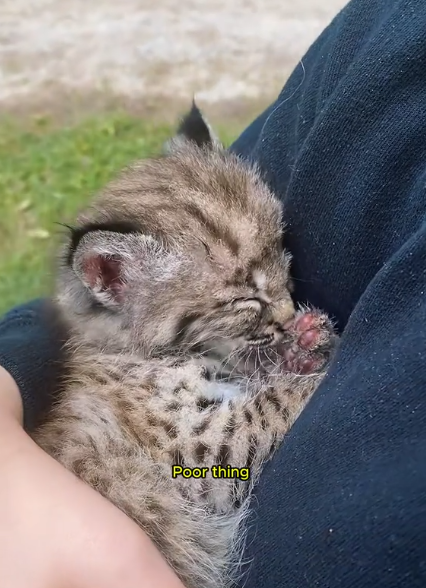
Weeks later, I received updates from the rehabilitation center. Willow had adapted well to her new life. She was healthy, hunting successfully, and even spotted with a small radio collar that tracked her movements.
Her story had become an inspiration—a reminder that even the smallest life deserves a chance, that kindness can bridge the gap between human and wild.
Adopting an orphaned bobcat kitten changed my life. It taught me patience, responsibility, and the fragile beauty of nature.
Most of all, it reminded me that sometimes, love means letting go.
If you ever find yourself face to face with a helpless wild animal, remember Willow’s story. Reach out to professionals, learn about the animal’s needs, and do everything you can to give them the best chance at life—whether in your care or in the wild where they belong.
